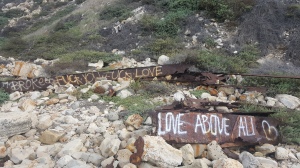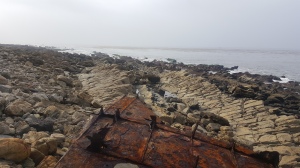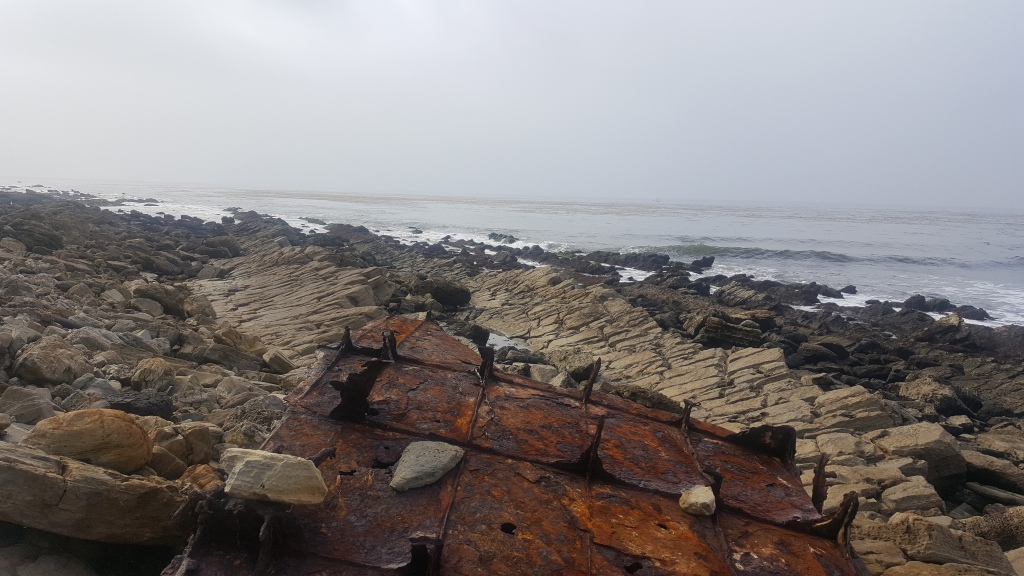In 1961, the freighter SS Dominator collided with the Palos Verdes Peninsula near Los Angeles. The World War II vessel that was originally named after the Chinese-Japanese war journalist Melville Jacoby made a navigational error en route to Los Angeles from Vancouver. The coast clenched the freighter. After a few days of attempting to refloat the vessel, the Coast Guard let the ocean have her.
Over the years, this ship has been ravaged by the constant force of Pacific. Even though it is a known location on Google Maps, reaching the Dominator is not as simple as walking down a paved road to read some signs for tourists. You have to seek out the obscured starting location, scale one-hundred and twenty-foot cliffs and traverse the rocky shore, endure the fly infested kelp and seaweed just to see a rust-covered vessel.
It’s more worth it than it sounds.
As mentioned before, to even start your journey, you need to put yourself in danger. Dismissing the whole idea as too much work would be easy. We followed our GPS to the site. Instead, we landed in a well-off neighborhood with no entrance in sight. We rounded the bend and saw a good starting point. The smell of the engulfing salt from the endless blue motivated us. We scurried about the edge of a cliff looking for a way down. We eventually located a dip on the terrain that appeared to be a start on the southern side of the beach.
The cliffs around this California coast are suggestions at best and traps at worst. The path, if you would even call it that, is a foot-worn decline that winds and bends. No railings here. Just a sign to warn you about the fines for littering and preserving local wildlife. Our best bet was to hug the inner lining and ensure our steps were surefooted. If we were hasty, the consequences would be severe. Personally, I do not find myself particularly nimble. My experience with ice skating came in handy as I found myself easily planting my feet and working my way down the coast, enjoying the workout.
My fiancee had a different experience.
She discovered that she might have a pretty intense fear of heights. She decided it’d be best not to trust in her feet, but physics instead. She lowered her center of gravity by sitting down and scooting her way down the hill. Slow, yet safe and efficient. And incredibly silly to watch from the bottom of a hill.
The reward for our patience was viewing the craggy coastal lining of California. However, there is a path just behind the decline where we found some spectacular sights.
We were greeted by a mossy cove that dripped sequential water droplets to a rhythm of its own. It echoed throughout the earthly scar’s nooks and crannies. Perhaps a mile from civilization, it was silent. No cars were humming along or locals chatting. Just the beat of the water and the occasional seagull.
We decided it is time to make progress towards the ship. The coast was kind at first. We traversed gentle, craggy terrain tenuously held together by century-smoothed rocks. This lasted for perhaps ten minutes, then the shore let us in on a secret. This hike was not designed to be a casual stroll.
This hike demanded respect.
The pebbles and stone gave way to jagged earth. The pleasant smell of the ocean breeze turned sour as we neared a kelp-laden corner. Thousands of flies would emerge as we passed like a tornado of pestilence. It was hard to maintain a steady pace as a swarm of black insects scattered from their scavenging of food.
The hike lasted forty minutes. We stopped around our fourth bend. The GPS, with a weak signal, confirmed that the Dominator was supposed to be at our current location. We became desperate for any payoff.
Of course, like any story, our goal happened to be around the next corner.
When we saw the orange glint of the dilapidated ship, we breathed easier. Not because we were doubting its existence. But instead, because we could enjoy a few minutes of not climbing over rocks and flies.
You could see all the pieces of the vessel strewn about the shore. It was obliterated not by force, but by time. As you inched closer, tiny roach-like insects skittered underneath our feet, seeking shelter under the sharp boulders. You can probably identify the parts of the ship if your nautical skills are up to par. Ours were not. We could distinguish that they were of naval vessel origin, perhaps the part that sat in the water, but nothing more. In some of my amateur photos, you will find an old LA tradition: good ol’ graffiti. We got a chuckle out of one in particular. Can you guess which one the Philadelphia native liked?

It’s this one.
The vehicle on the beach is a tank if our sources can confirm anything at all. What source is that? We don’t remember. What it looks to be carrying is a cross between a burnt cheese casserole and liquid magma. We, unfortunately, did not test out our hypothesis and decided to leave its origin a mystery.
Another sad yet fitting addition to this trip was the discovery of a seal carcass. Either washed ashore or it met its demise there, it now rests not thirty feet away from the main pieces of the ship. Only the skin remains of this ghastly corpse. It did not smell, strangely enough. It left no hint to its existence, only able to be noticed as you prodded along.
We quickly became worried about finding a way back to our starting location. We were unable to reach a verdict whether retracing our steps or scaling the cliff would be worse for our bodies. The easier decision was to keep moving forward, so we did. We found what appeared to be the landing site of the vessel. The land was torn asunder by the emergency and smoothed over by years of pressure. It looks as the earth was the destination of an awry meteorite and not a medium-sized freighter.

When we started to notice other travelers and the litter of bottom cap rims and Heineken, we knew we had to be close. We figured these people, smarter than us, had come from an easier path. That intuition was correct, as we found a large pipe that formed a spine of the cliff. Just as steep and without any logical way as the initial descent, we scaled this concrete Godzilla toward civilization. We took one last look back as we caught our breath.
Was it a tour through the Congo or a hike to Chichen Itza? That would be a resounding “No.” But it was an adventure enough for two homesick twenty-somethings desperate to be away from the hustle and bustle of the 10. And it served that purpose admirably.

Party on.
